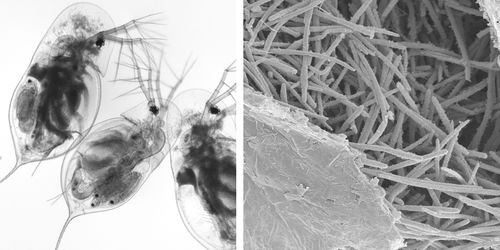Metschnikowia bicuspidata: Difference between revisions
m (→References) |
|||
| Line 40: | Line 40: | ||
If relevant, how does this organism cause disease? Human, animal, plant hosts? Virulence factors, as well as patient symptoms.<br><br> | If relevant, how does this organism cause disease? Human, animal, plant hosts? Virulence factors, as well as patient symptoms.<br><br> | ||
''M. bicuspidata'' kills the host ''D. magna'' in 7-25 days; a healthy ''D. magna'' typically lives 40-80 days (Ebert et al., 2000). | |||
Transmission is horizontal, meaning infection occurs within a host generation and is not transmitted from parent to offspring (Ebert et al., 2000). | Transmission is horizontal, meaning infection occurs within a host generation and is not transmitted from parent to offspring (Ebert et al., 2000). | ||
A single ''Daphnia'' carcass can dispense up to 70,000 spores into the water column (Penczykowski et al., 2014). | A single ''Daphnia'' carcass can dispense up to 70,000 spores into the water column (Penczykowski et al., 2014). | ||
| Line 48: | Line 51: | ||
contributions to environment | contributions to environment | ||
how cause disease? | how cause disease? | ||
==References== | ==References== | ||
Revision as of 18:12, 27 April 2015
Introduction
Metschnikowia is a genus in the Kingdom Fungi (Naumov, 2011). Metschnikowia species are single-celled (i.e., yeast) parasites of the freshwater zooplankton genus Daphnia (ibid.).
Description and Significance
The organism exists as single-celled needle-shaped spores (Naumov, 2011). Metschnikowia lives in freshwater lakes ___where? It survives by ___ M. bicuspidata is a pathogen of Daphnia. If infection is successful, a M. bicuspidata spore uses the host's body to produce tens of thousands of identical spores. These increase in number until the Daphnia is killed and its carapace ruptures, introducing thousands of new spores into the water column.
Classification
Eukaryota, Fungi, Dikarya, Ascomycota, Saccharomycotina, Saccharomycetes, Saccharomycetales, Metschnikowiaceae, Metschnikowia (European Nucleotide Archive, accessed 21 April 2015)
Species
There are three varieties in the species: M. bicuspidata var. bicuspidata, var. californica, and var. chathamia (Naumov, 2011).
Genome Structure
Describe the size and content of the genome. How many chromosomes? Circular or linear? Other interesting features? What is known about its sequence?
Cell Structure, Metabolism and Life Cycle
Interesting features of cell structure; how it gains energy; what important molecules it produces.
M. bicuspidata gains energy by parasitising the freshwater zooplankton Daphnia. Daphnia encounter spores during feeding; the spores enter the Daphnia mouth along with algae and other small particles. Infection of Daphnia is successful if a spore can puncture the gut wall and begin reproducing, enclosed in the Daphnia body.
Within the Daphnia body, M. bicuspidata uses energetic resources in the Daphnia body to reproduce (Hall et al., 2009).
Susceptibility to infection varies across host genotypes ( ).
Upon death due to infection, Daphnia may yield 10,000 to 70,000 spores per individual (Penczykowski et al., 2014).
Ecology and Pathogenesis
Habitat; symbiosis; biogeochemical significance; contributions to environment.
If relevant, how does this organism cause disease? Human, animal, plant hosts? Virulence factors, as well as patient symptoms.
M. bicuspidata kills the host D. magna in 7-25 days; a healthy D. magna typically lives 40-80 days (Ebert et al., 2000). Transmission is horizontal, meaning infection occurs within a host generation and is not transmitted from parent to offspring (Ebert et al., 2000). A single Daphnia carcass can dispense up to 70,000 spores into the water column (Penczykowski et al., 2014).
habitat symbionts biogeochemical significance contributions to environment how cause disease?
References
http://www.ebi.ac.uk/ena/data/view/Taxon:Metschnikowia%20bicuspidata%20var.%20bicuspidata%20NRRL%20YB-4993 European Nucleotide Archive. Metschnikowia bicuspidata var. bicuspidata NRRL YB-4993. accessed 21 April 2015.
Ebert, D., Lipsitch, M., Mangin, K. L. "The Effect of Parasites on Host Population Density and Extinction: Experimental Epidemiology with Daphnia and Six Microparasites." The American Naturalist. 2000. Volume 156(5). pp. 459-477.
Hall, S. R., Simonis, J. L., Nisbet, R. M., Tessier, A. J., Cáceres, C. E. "Resource Ecology of Virulence in a Planktonic Host‐Parasite System: An Explanation Using Dynamic Energy Budgets." The American Naturalist. 2009. Volume 174(2). pp. 149-162.
Naumov, G. I. "Molecular and genetic differentiation of small-spored species of the yeast genus Metschnikowia Kamienski." Microbiology. 2011. Volume 80(2). pp. 135-142.
Penczykowski, R. M., Lemanski, B. C. P., Sieg, R. D., Hall, S. R., Ochs, J. H., Kubanek, J., Duffy, M. A. "Poor resource quality lowers transmission potential by changing foraging behavior." Functional Ecology. 2014. Volume 28. pp. 1245-1255.
Author
Page authored by Katie Griebel and Jacob Gelarden, students of Prof. Jay Lennon at Indiana University.

